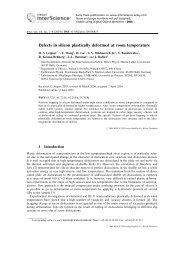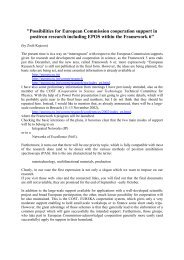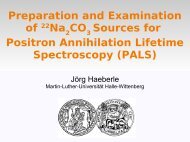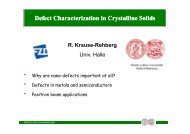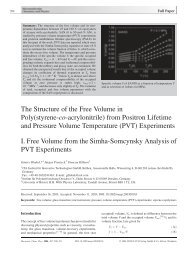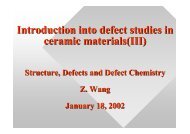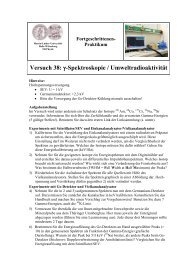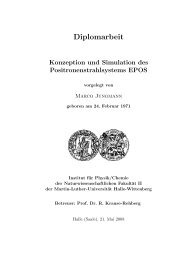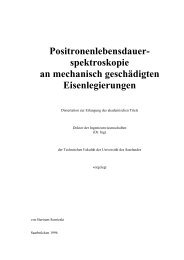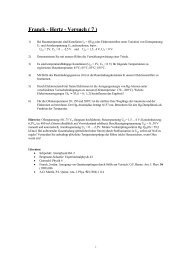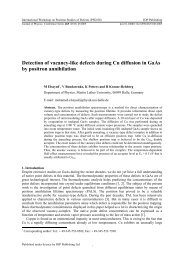Digital Positron Lifetime @ EPOS - Positron Annihilation in Halle
Digital Positron Lifetime @ EPOS - Positron Annihilation in Halle
Digital Positron Lifetime @ EPOS - Positron Annihilation in Halle
Create successful ePaper yourself
Turn your PDF publications into a flip-book with our unique Google optimized e-Paper software.
<strong>Positron</strong>s <strong>EPOS</strong> <strong>Digital</strong> <strong>Positron</strong> <strong>Lifetime</strong> The Influence of Noise Next Tasks Conclusion<br />
<strong>Digital</strong> <strong>Positron</strong> <strong>Lifetime</strong> @ <strong>EPOS</strong><br />
Arnold Krille 1 Wolfgang Anwand 2 Marco Jungmann 1 Nicki<br />
H<strong>in</strong>sche 1,2 Re<strong>in</strong>hard Krause-Reberg 1<br />
1 Department of Physics, Mart<strong>in</strong>-Luther-University <strong>Halle</strong>-Wittenberg, 06108 <strong>Halle</strong>, Germany<br />
2 Institut of Ion Beam Physics, Research Center Dresden-Rossendorf, 01314 Dresden, Germany<br />
University Leipzig – Oktober 22th, 2008<br />
DPL @ <strong>EPOS</strong> A Krille, et al.
<strong>Positron</strong>s <strong>EPOS</strong> <strong>Digital</strong> <strong>Positron</strong> <strong>Lifetime</strong> The Influence of Noise Next Tasks Conclusion<br />
Contents<br />
1 Introduction: <strong>Positron</strong>s <strong>in</strong> Material Research<br />
2 Introduction: <strong>EPOS</strong><br />
3 <strong>Digital</strong> <strong>Positron</strong> <strong>Lifetime</strong><br />
4 The Influence of Noise<br />
5 Next Tasks<br />
6 Conclusion<br />
DPL @ <strong>EPOS</strong> A Krille, et al.
<strong>Positron</strong>s <strong>EPOS</strong> <strong>Digital</strong> <strong>Positron</strong> <strong>Lifetime</strong> The Influence of Noise Next Tasks Conclusion<br />
<strong>Positron</strong>s<br />
für 22-Na:<br />
Quant<br />
(1.27 MeV)<br />
<strong>Positron</strong>ene<strong>in</strong>fang durch Kristalldefekte<br />
Quant (511 keV)<br />
• <strong>Positron</strong>en-Wellenfunktion wird im Defekt lokalisiert<br />
• <strong>Annihilation</strong>sparameter ändern sich, wenn <strong>Positron</strong> im Defekt zerstrahlt<br />
DPL @ <strong>EPOS</strong> A Krille, et al.
<strong>Positron</strong>s <strong>EPOS</strong> <strong>Digital</strong> <strong>Positron</strong> <strong>Lifetime</strong> The Influence of Noise Next Tasks Conclusion<br />
<strong>Positron</strong>s: Decay Parameters<br />
DPL @ <strong>EPOS</strong> A Krille, et al.
<strong>Positron</strong>s <strong>EPOS</strong> <strong>Digital</strong> <strong>Positron</strong> <strong>Lifetime</strong> The Influence of Noise Next Tasks Conclusion<br />
<strong>Positron</strong>s: Decay Parameters<br />
DPL @ <strong>EPOS</strong> A Krille, et al.
<strong>Positron</strong>s <strong>EPOS</strong> <strong>Digital</strong> <strong>Positron</strong> <strong>Lifetime</strong> The Influence of Noise Next Tasks Conclusion<br />
<strong>Positron</strong>s: Decay Parameters<br />
DPL @ <strong>EPOS</strong> A Krille, et al.
<strong>Positron</strong>s <strong>EPOS</strong> <strong>Digital</strong> <strong>Positron</strong> <strong>Lifetime</strong> The Influence of Noise Next Tasks Conclusion<br />
Fields of Usage<br />
DPL @ <strong>EPOS</strong> A Krille, et al.
<strong>Positron</strong>s <strong>EPOS</strong> <strong>Digital</strong> <strong>Positron</strong> <strong>Lifetime</strong> The Influence of Noise Next Tasks Conclusion<br />
<strong>EPOS</strong> @ ELBE<br />
DPL @ <strong>EPOS</strong> A Krille, et al.
<strong>Positron</strong>s <strong>EPOS</strong> <strong>Digital</strong> <strong>Positron</strong> <strong>Lifetime</strong> The Influence of Noise Next Tasks Conclusion<br />
Basic Concept<br />
Schema des <strong>EPOS</strong>-Systems<br />
<strong>EPOS</strong> Systems<br />
DPL @ <strong>EPOS</strong> A Krille, et al.
<strong>Positron</strong>s <strong>EPOS</strong> <strong>Digital</strong> <strong>Positron</strong> <strong>Lifetime</strong> The Influence of Noise Next Tasks Conclusion<br />
Key features of <strong>EPOS</strong><br />
<strong>Positron</strong>s by pair production<br />
Unique time structure<br />
High repetition rate (77ns)<br />
Sharp pulses (∼5ps)<br />
Mach<strong>in</strong>e pulse for start of lifetime measurements<br />
Good tim<strong>in</strong>g resolution<br />
Full digitial measurement and control<br />
Project started 2001<br />
First positrons planned for end 2008<br />
User dedicated facility<br />
User access should start 2009/2010<br />
DPL @ <strong>EPOS</strong> A Krille, et al.
<strong>Positron</strong>s <strong>EPOS</strong> <strong>Digital</strong> <strong>Positron</strong> <strong>Lifetime</strong> The Influence of Noise Next Tasks Conclusion<br />
Basic Setup<br />
Analog Setup:<br />
γ-quants detected by sc<strong>in</strong>tillator and<br />
photomultiplier<br />
Energy-discrim<strong>in</strong>ation with SCA<br />
Event extraction with CF<br />
Time measurement with TAC<br />
Spectrum with MCA<br />
Start Stop<br />
Detektor Detektor<br />
SCA<br />
CF<br />
Start Stop<br />
DPL @ <strong>EPOS</strong> A Krille, et al.<br />
TAC<br />
MCA<br />
PC<br />
SCA<br />
CF
<strong>Positron</strong>s <strong>EPOS</strong> <strong>Digital</strong> <strong>Positron</strong> <strong>Lifetime</strong> The Influence of Noise Next Tasks Conclusion<br />
Analog vs. <strong>Digital</strong><br />
The task<br />
Replace all the (50+ years old) analog<br />
electronics with PC, digitizer and<br />
mathematics.<br />
Benefits of digital process<strong>in</strong>g:<br />
+ Cheaper<br />
+ Simplier<br />
+ Better time base<br />
+ Easy to extent/change<br />
- Less knowledge available<br />
? Better tim<strong>in</strong>g resolution<br />
DPL @ <strong>EPOS</strong> A Krille, et al.
<strong>Positron</strong>s <strong>EPOS</strong> <strong>Digital</strong> <strong>Positron</strong> <strong>Lifetime</strong> The Influence of Noise Next Tasks Conclusion<br />
The Algorithms to Extract the Tim<strong>in</strong>g Information<br />
0.2<br />
0<br />
-0.2<br />
-0.4<br />
-0.6<br />
-0.8<br />
-1<br />
-1.2<br />
-1.4<br />
Pulse<br />
25 30 35 40 45 50 55 60<br />
How to extract the tim<strong>in</strong>g <strong>in</strong>formation?<br />
DPL @ <strong>EPOS</strong> A Krille, et al.
<strong>Positron</strong>s <strong>EPOS</strong> <strong>Digital</strong> <strong>Positron</strong> <strong>Lifetime</strong> The Influence of Noise Next Tasks Conclusion<br />
Algorithms: PolyCF<br />
0.2<br />
0<br />
-0.2<br />
-0.4<br />
-0.6<br />
-0.8<br />
-1<br />
-1.2<br />
M<strong>in</strong>imum<br />
-1.4<br />
Pulse<br />
25 30 35 40 45 50 55 60<br />
1 By simple polynom <strong>in</strong>terpolation of 3rd order.<br />
1 F<strong>in</strong>d and <strong>in</strong>terpolate the<br />
extremum 1<br />
2 Determ<strong>in</strong>e the zerol<strong>in</strong>e (and<br />
its deviation) before the<br />
extremum<br />
3 Interpolate the constant<br />
fraction po<strong>in</strong>t on the ris<strong>in</strong>g<br />
slope between zerol<strong>in</strong>e and<br />
extremum 1<br />
4 <strong>Lifetime</strong> =<br />
tChannel 1 − tChannel 2<br />
DPL @ <strong>EPOS</strong> A Krille, et al.
<strong>Positron</strong>s <strong>EPOS</strong> <strong>Digital</strong> <strong>Positron</strong> <strong>Lifetime</strong> The Influence of Noise Next Tasks Conclusion<br />
Algorithms: PolyCF<br />
0.2<br />
0<br />
-0.2<br />
-0.4<br />
-0.6<br />
-0.8<br />
-1<br />
-1.2<br />
Zerol<strong>in</strong>e<br />
M<strong>in</strong>imum<br />
-1.4<br />
Pulse<br />
25 30 35 40 45 50 55 60<br />
1 By simple polynom <strong>in</strong>terpolation of 3rd order.<br />
1 F<strong>in</strong>d and <strong>in</strong>terpolate the<br />
extremum 1<br />
2 Determ<strong>in</strong>e the zerol<strong>in</strong>e (and<br />
its deviation) before the<br />
extremum<br />
3 Interpolate the constant<br />
fraction po<strong>in</strong>t on the ris<strong>in</strong>g<br />
slope between zerol<strong>in</strong>e and<br />
extremum 1<br />
4 <strong>Lifetime</strong> =<br />
tChannel 1 − tChannel 2<br />
DPL @ <strong>EPOS</strong> A Krille, et al.
<strong>Positron</strong>s <strong>EPOS</strong> <strong>Digital</strong> <strong>Positron</strong> <strong>Lifetime</strong> The Influence of Noise Next Tasks Conclusion<br />
Algorithms: PolyCF<br />
0.2<br />
0<br />
-0.2<br />
-0.4<br />
-0.6<br />
-0.8<br />
-1<br />
CF 0.2<br />
-1.2<br />
Zerol<strong>in</strong>e<br />
M<strong>in</strong>imum<br />
-1.4<br />
Pulse<br />
25 30 35 40 45 50 55 60<br />
1 By simple polynom <strong>in</strong>terpolation of 3rd order.<br />
1 F<strong>in</strong>d and <strong>in</strong>terpolate the<br />
extremum 1<br />
2 Determ<strong>in</strong>e the zerol<strong>in</strong>e (and<br />
its deviation) before the<br />
extremum<br />
3 Interpolate the constant<br />
fraction po<strong>in</strong>t on the ris<strong>in</strong>g<br />
slope between zerol<strong>in</strong>e and<br />
extremum 1<br />
4 <strong>Lifetime</strong> =<br />
tChannel 1 − tChannel 2<br />
DPL @ <strong>EPOS</strong> A Krille, et al.
<strong>Positron</strong>s <strong>EPOS</strong> <strong>Digital</strong> <strong>Positron</strong> <strong>Lifetime</strong> The Influence of Noise Next Tasks Conclusion<br />
Algorithms: PolyCF<br />
0.2<br />
0<br />
-0.2<br />
-0.4<br />
-0.6<br />
-0.8<br />
-1<br />
CF 0.2<br />
-1.2<br />
Zerol<strong>in</strong>e<br />
M<strong>in</strong>imum<br />
-1.4<br />
Pulse<br />
25 30 35 40 45 50 55 60<br />
1 F<strong>in</strong>d and <strong>in</strong>terpolate the<br />
extremum 1<br />
2 Determ<strong>in</strong>e the zerol<strong>in</strong>e (and<br />
its deviation) before the<br />
extremum<br />
3 Interpolate the constant<br />
fraction po<strong>in</strong>t on the ris<strong>in</strong>g<br />
slope between zerol<strong>in</strong>e and<br />
extremum 1<br />
4 <strong>Lifetime</strong> =<br />
tChannel 1 − tChannel 2<br />
Similar to analog constant fraction, called true constant fraction by<br />
[Bečváˇr, 2007].<br />
DPL @ <strong>EPOS</strong> A Krille, et al.
<strong>Positron</strong>s <strong>EPOS</strong> <strong>Digital</strong> <strong>Positron</strong> <strong>Lifetime</strong> The Influence of Noise Next Tasks Conclusion<br />
Algorithms: <strong>in</strong>tegral Constant Fraction (iCF)<br />
1 Integrate the pulse<br />
2 Filter on risetime of <strong>in</strong>tegrated signal<br />
rightarrow Pulse-shape of orig<strong>in</strong>al signal<br />
3 Do true constant fraction like before on <strong>in</strong>tegrated signal<br />
Seems to give better tim<strong>in</strong>g resolution of 144ps [Bečváˇr, 2007].<br />
DPL @ <strong>EPOS</strong> A Krille, et al.
<strong>Positron</strong>s <strong>EPOS</strong> <strong>Digital</strong> <strong>Positron</strong> <strong>Lifetime</strong> The Influence of Noise Next Tasks Conclusion<br />
Tim<strong>in</strong>g Resolutions<br />
Method Lit. / Setup Resolution (FWHM)<br />
Analog measurements our lab: >200ps<br />
Polynom-Int. [Bečváˇr et al., 2005] 150ps<br />
4GS/s 1GHz 8bit:<br />
4GS/s 1GHz 8bit ∼170ps 60 Co, 230ps Si<br />
Gauss-Int. [Aavikko et al., 2005] 200ps<br />
4GS/s 1GHz 8bit:<br />
(Smooth<strong>in</strong>g) Spl<strong>in</strong>e [Saito et al., 2002] 118ps - 144ps<br />
4GS/s 1GHz 8bit:<br />
[Bardelli et al., 2004] 100ps - 125ps<br />
100MS/s 50MHz 12bit:<br />
∼170ps 60 Co<br />
Integral CF [Bečváˇr, 2007] ∼144ps<br />
DPL @ <strong>EPOS</strong> A Krille, et al.
<strong>Positron</strong>s <strong>EPOS</strong> <strong>Digital</strong> <strong>Positron</strong> <strong>Lifetime</strong> The Influence of Noise Next Tasks Conclusion<br />
The Influence of Noise: Generated Pulses<br />
Input Voltage<br />
0.2<br />
0<br />
-0.2<br />
-0.4<br />
-0.6<br />
-0.8<br />
-1<br />
-1.2<br />
-1.4<br />
-1.6<br />
0 20 40 60 80 100<br />
Side Note<br />
Time [samples]<br />
Channel 1<br />
Channel 2<br />
Four pulse pairs generated<br />
by <strong>EPOS</strong> Software<br />
The <strong>EPOS</strong> Software is gone open-source and look<strong>in</strong>g for users!<br />
See http://positron.physik.uni-halle.de/<strong>EPOS</strong>/Software.<br />
DPL @ <strong>EPOS</strong> A Krille, et al.
<strong>Positron</strong>s <strong>EPOS</strong> <strong>Digital</strong> <strong>Positron</strong> <strong>Lifetime</strong> The Influence of Noise Next Tasks Conclusion<br />
The Influence of Noise: Shape<br />
Input Voltage<br />
0.2<br />
0<br />
-0.2<br />
-0.4<br />
-0.6<br />
-0.8<br />
-1<br />
-1.2<br />
-1.4<br />
-1.6<br />
0 20 40 60 80 100<br />
Time [samples]<br />
Channel 1<br />
Channel 2<br />
Shaped like LSO on<br />
Hamamatsu H3378-50<br />
Risetime like 4 GS/s<br />
DPL @ <strong>EPOS</strong> A Krille, et al.
<strong>Positron</strong>s <strong>EPOS</strong> <strong>Digital</strong> <strong>Positron</strong> <strong>Lifetime</strong> The Influence of Noise Next Tasks Conclusion<br />
The Influence of Noise: Energy Spectrum<br />
Counts<br />
1000<br />
100<br />
10<br />
1<br />
-2 -1.8 -1.6 -1.4 -1.2 -1 -0.8 -0.6 -0.4 -0.2 0<br />
Input Voltage<br />
Energy spectrum closely to 22 Na but idealistic.<br />
Shaped like LSO on<br />
Hamamatsu H3378-50<br />
Risetime like 4 GS/s<br />
Energy distribution<br />
like 22 Na<br />
DPL @ <strong>EPOS</strong> A Krille, et al.
<strong>Positron</strong>s <strong>EPOS</strong> <strong>Digital</strong> <strong>Positron</strong> <strong>Lifetime</strong> The Influence of Noise Next Tasks Conclusion<br />
The Influence of Noise: Tim<strong>in</strong>g Distribution<br />
Counts<br />
100000<br />
10000<br />
1000<br />
100<br />
10<br />
1<br />
-0.01 -0.005 0 0.005 0.01<br />
Time [samples]<br />
Shift between pulses is Gaussian distributed.<br />
Shift of pulses to sampl<strong>in</strong>g clock is box distributed.<br />
Shaped like LSO on<br />
Hamamatsu H3378-50<br />
Risetime like 4 GS/s<br />
Energy distribution<br />
like 22 Na<br />
Gaussian distributed<br />
tim<strong>in</strong>g<br />
DPL @ <strong>EPOS</strong> A Krille, et al.
<strong>Positron</strong>s <strong>EPOS</strong> <strong>Digital</strong> <strong>Positron</strong> <strong>Lifetime</strong> The Influence of Noise Next Tasks Conclusion<br />
The Influence of Noise: Bit-depth<br />
Input Voltage<br />
0.2<br />
0<br />
-0.2<br />
-0.4<br />
-0.6<br />
-0.8<br />
-1<br />
-1.2<br />
-1.4<br />
-1.6<br />
0 20 40 60 80 100<br />
Time [samples]<br />
Channel 1<br />
Channel 2<br />
Possible bit-depths: 1-32 bits<br />
Native double resolution also possible<br />
Shaped like LSO on<br />
Hamamatsu H3378-50<br />
Risetime like 4 GS/s<br />
Energy distribution<br />
like 22 Na<br />
Gaussian distributed<br />
tim<strong>in</strong>g<br />
Variable bit-depth<br />
DPL @ <strong>EPOS</strong> A Krille, et al.
<strong>Positron</strong>s <strong>EPOS</strong> <strong>Digital</strong> <strong>Positron</strong> <strong>Lifetime</strong> The Influence of Noise Next Tasks Conclusion<br />
The Influence of Noise: Add<strong>in</strong>g Noise<br />
Input Voltage<br />
0.2<br />
0<br />
-0.2<br />
-0.4<br />
-0.6<br />
-0.8<br />
-1<br />
-1.2<br />
-1.4<br />
-1.6<br />
0 20 40 60 80 100<br />
Time [samples]<br />
Channel 1<br />
Channel 2<br />
Shaped like LSO on<br />
Hamamatsu H3378-50<br />
Risetime like 4 GS/s<br />
Energy distribution<br />
like 22 Na<br />
Gaussian distributed<br />
tim<strong>in</strong>g<br />
Variable bit-depth<br />
White noise added as<br />
wanted<br />
White noise to simulate the uncerta<strong>in</strong>ties of the analog electronics.<br />
Level can be adjusted as wanted.<br />
DPL @ <strong>EPOS</strong> A Krille, et al.
<strong>Positron</strong>s <strong>EPOS</strong> <strong>Digital</strong> <strong>Positron</strong> <strong>Lifetime</strong> The Influence of Noise Next Tasks Conclusion<br />
Double Resolution without Noise<br />
Counts<br />
1000<br />
100<br />
10<br />
Tim<strong>in</strong>g distribution (double resolution, no noise)<br />
1<br />
-0.02 -0.015 -0.01 -0.005 0 0.005 0.01 0.015 0.02<br />
Time [samples]<br />
Determ<strong>in</strong>ed<br />
Given<br />
No noise, native double resolution<br />
Given tim<strong>in</strong>g distribution: FWHM = 0.0023582 samples ≡ 0.589 ps<br />
Given distribution (−) ≡ determ<strong>in</strong>ed resolution (×)<br />
⇒ Method works<br />
DPL @ <strong>EPOS</strong> A Krille, et al.
<strong>Positron</strong>s <strong>EPOS</strong> <strong>Digital</strong> <strong>Positron</strong> <strong>Lifetime</strong> The Influence of Noise Next Tasks Conclusion<br />
Reduc<strong>in</strong>g the Bit-depth<br />
FWHM [samples]<br />
1<br />
0.1<br />
0.01<br />
0.001<br />
Reduced bit-depth, no noise<br />
6 8 10 12 14 16<br />
Bit-depth<br />
Tim<strong>in</strong>g resolution at 8-bit: 0.202 samples ≡ 50 ps<br />
DPL @ <strong>EPOS</strong> A Krille, et al.
<strong>Positron</strong>s <strong>EPOS</strong> <strong>Digital</strong> <strong>Positron</strong> <strong>Lifetime</strong> The Influence of Noise Next Tasks Conclusion<br />
Noise of Effective Bits<br />
FWHM [samples]<br />
1<br />
0.1<br />
0.01<br />
0.001<br />
0.0001 0.001 0.01 0.1<br />
Noise-Level<br />
Native double resolution, noise accord<strong>in</strong>g to effective bits added<br />
Strong log-log dependency of tim<strong>in</strong>g resolution and noise level.<br />
DPL @ <strong>EPOS</strong> A Krille, et al.
<strong>Positron</strong>s <strong>EPOS</strong> <strong>Digital</strong> <strong>Positron</strong> <strong>Lifetime</strong> The Influence of Noise Next Tasks Conclusion<br />
Noise and Reduced Bit-depth<br />
FWHM [samples]<br />
1<br />
0.1<br />
0.01<br />
0.001<br />
6 8 10 12 14 16<br />
Bit-depth<br />
Reduced bit-depth and noise from effective bits<br />
Tim<strong>in</strong>g resolution at 8-bit: 0.612 samples ≡ 153 ps<br />
DPL @ <strong>EPOS</strong> A Krille, et al.
<strong>Positron</strong>s <strong>EPOS</strong> <strong>Digital</strong> <strong>Positron</strong> <strong>Lifetime</strong> The Influence of Noise Next Tasks Conclusion<br />
F<strong>in</strong>ally Compar<strong>in</strong>g the results<br />
FWHM [samples]<br />
1<br />
0.1<br />
0.01<br />
0.001<br />
given tim<strong>in</strong>g fwhm (0.00235 samples)<br />
bits + noise<br />
bits<br />
noise (bits-1.5 = effective bits)<br />
6 8 10 12 14 16<br />
Bit-depth<br />
Noise from effective bits has most <strong>in</strong>fluence<br />
Result<strong>in</strong>g tim<strong>in</strong>g resolutions: 8-bit: 153 ps, 10-bit: 41 ps<br />
DPL @ <strong>EPOS</strong> A Krille, et al.
<strong>Positron</strong>s <strong>EPOS</strong> <strong>Digital</strong> <strong>Positron</strong> <strong>Lifetime</strong> The Influence of Noise Next Tasks Conclusion<br />
The Influence of Noise<br />
Level [dB]<br />
-20<br />
-30<br />
-40<br />
-50<br />
-60<br />
-70<br />
-80<br />
-90<br />
Filter<strong>in</strong>g Noise with the Butterworth-Filter<br />
-100<br />
0 0.1 0.2 0.3 0.4 0.5<br />
Frequency relative of the sampl<strong>in</strong>g rate<br />
N = 1<br />
N = 2<br />
N = 3<br />
N = 5<br />
N = 10<br />
f = 0.1<br />
f = 0.2<br />
f = 0.3<br />
f = 0.4<br />
Butterworth lowpass (implementation taken from literature<br />
[Stearns, 1975])<br />
Order and cutoff frequency can be set<br />
DPL @ <strong>EPOS</strong> A Krille, et al.
<strong>Positron</strong>s <strong>EPOS</strong> <strong>Digital</strong> <strong>Positron</strong> <strong>Lifetime</strong> The Influence of Noise Next Tasks Conclusion<br />
The Influence of Noise<br />
0<br />
-0.25<br />
-0.5<br />
-0.75<br />
-1<br />
-1.25<br />
0<br />
-0.25<br />
-0.5<br />
-0.75<br />
-1<br />
-1.25<br />
Unfiltered<br />
0 20 40 60 80 100<br />
f=0.1 N=1<br />
0 20 40 60 80 100<br />
0<br />
-0.25<br />
-0.5<br />
-0.75<br />
-1<br />
-1.25<br />
0<br />
-0.25<br />
-0.5<br />
-0.75<br />
-1<br />
-1.25<br />
Upper row Orig<strong>in</strong>al signals as generated<br />
Lower row Filtered by lowpass<br />
Unfiltered<br />
0 20 40 60 80 100<br />
f=0.1 N=2<br />
0 20 40 60 80 100<br />
0<br />
-0.25<br />
-0.5<br />
-0.75<br />
-1<br />
-1.25<br />
0<br />
-0.25<br />
-0.5<br />
-0.75<br />
-1<br />
-1.25<br />
Unfilter<br />
0 20 40 6<br />
f=0.2 N<br />
0 20 40 6<br />
DPL @ <strong>EPOS</strong> A Krille, et al.
<strong>Positron</strong>s <strong>EPOS</strong> <strong>Digital</strong> <strong>Positron</strong> <strong>Lifetime</strong> The Influence of Noise Next Tasks Conclusion<br />
The Influence of Noise: Results<br />
Determ<strong>in</strong>ed tim<strong>in</strong>g FWHM [samples]<br />
(Should be 0.00235)<br />
0.44<br />
0.42<br />
0.4<br />
0.38<br />
0.36<br />
0.34<br />
0.32<br />
0.3<br />
Best Tim<strong>in</strong>g Resolution<br />
0.05 0.1 0.15 0.2<br />
Cutoff Frequency [sampl<strong>in</strong>grate]<br />
N=1<br />
N=2<br />
N=3<br />
N=4<br />
N = 1 and f = 0.05 has FWHM of 0.31 samples ≡ 75 ps.<br />
DPL @ <strong>EPOS</strong> A Krille, et al.
<strong>Positron</strong>s <strong>EPOS</strong> <strong>Digital</strong> <strong>Positron</strong> <strong>Lifetime</strong> The Influence of Noise Next Tasks Conclusion<br />
Comparison of the Results<br />
Method Relative Tim<strong>in</strong>g 4-GS/s “real”<br />
FWHM [samples] FWHM [ps]<br />
Vertical quantization (8-bit) 0.202 samples 50 ps<br />
Noise of effective 6.5 bit 0.612 samples 153 ps<br />
Butterworth-Lowpass 0.314 samples 75 ps<br />
f=0.05 N=1<br />
Compar<strong>in</strong>g the results.<br />
Lowpass filter<strong>in</strong>g can almost remove the effect of the noise added from<br />
the analog electronics.<br />
⇒ All with simple polynom <strong>in</strong>terpolation for energy and constant fraction.<br />
DPL @ <strong>EPOS</strong> A Krille, et al.
<strong>Positron</strong>s <strong>EPOS</strong> <strong>Digital</strong> <strong>Positron</strong> <strong>Lifetime</strong> The Influence of Noise Next Tasks Conclusion<br />
Next Task: Compar<strong>in</strong>g Photomultipliers<br />
Compar<strong>in</strong>g Photomultipliers<br />
Hamamatsu H3378-50<br />
Photonis XP20Z8<br />
Measurement Program:<br />
Energy resolution (same sc<strong>in</strong>tillators!)<br />
Tim<strong>in</strong>g resolution (same sc<strong>in</strong>tillators and source/sample)<br />
– currently runn<strong>in</strong>g<br />
Risetime, Pile-up, Pulse-Shape (DFT, etc...)<br />
DPL @ <strong>EPOS</strong> A Krille, et al.
<strong>Positron</strong>s <strong>EPOS</strong> <strong>Digital</strong> <strong>Positron</strong> <strong>Lifetime</strong> The Influence of Noise Next Tasks Conclusion<br />
Next Task: Compar<strong>in</strong>g Sc<strong>in</strong>tillators<br />
Compare Sc<strong>in</strong>tillators<br />
BaF2<br />
LSO<br />
ZnO<br />
LaBr3(Ce)<br />
Measurement Program:<br />
Energy Spectrum/Resolution<br />
Risetime / Pulse-shape<br />
Relative Effectivity (through 1<br />
r 2 )<br />
Optical Spectrum<br />
DPL @ <strong>EPOS</strong> A Krille, et al.
<strong>Positron</strong>s <strong>EPOS</strong> <strong>Digital</strong> <strong>Positron</strong> <strong>Lifetime</strong> The Influence of Noise Next Tasks Conclusion<br />
Thanks for your attention!<br />
Get the slides from http://positron.physik.uni-halle.de.<br />
[Aavikko et al., 2005] Aavikko, R., Rytsölä, K., Nissilä, J., and Saar<strong>in</strong>en, K. (2005).<br />
Stability and performance characteristics of a digital positron lifetime spectrometer.<br />
ACTA PHYSICA POLONICA A, 107.<br />
[Bardelli et al., 2004] Bardelli, L., Poggi, G., B<strong>in</strong>i, M., Pasquali, G., and Taccetti, N. (2004).<br />
Time measurements by means of digital sampl<strong>in</strong>g techniques: a study case of 100 ps fwhm time resolution with a 100msample/s, 12<br />
bit digitizer.<br />
Nuclear Instruments and Methods <strong>in</strong> Physics Research A, 521:480–492.<br />
[Bečváˇr, 2007] Bečváˇr, F. (2007).<br />
Methodology of positron lifetime spectroscopy: Present status and perspectives.<br />
Nuclear Instruments and Methods <strong>in</strong> Physics Research B, 261:871–874.<br />
[Bečváˇr et al., 2005] Bečváˇr, F., Ĉíˇzek, J., Procházka, I., and Janotová, J. (2005).<br />
The asset of ultra-fast digitizers for positron-lifetime spectroscopy.<br />
Nuclear Instruments and Methods <strong>in</strong> Physics Research A, 539:372–385.<br />
[Saito et al., 2002] Saito, H., Nagashima, Y., Kurihara, T., and Hyodo, T. (2002).<br />
A new positron lifetime spectrometer us<strong>in</strong>g a fast digital oscilloscope and baf 2 sc<strong>in</strong>tillators.<br />
Nuclear Instruments and Methods <strong>in</strong> Physics Research A, 487:612–617.<br />
[Stearns, 1975] Stearns, S. D. (1975).<br />
<strong>Digital</strong> Signal Analysis.<br />
Hayden Book Company Inc.<br />
DPL @ <strong>EPOS</strong> A Krille, et al.



